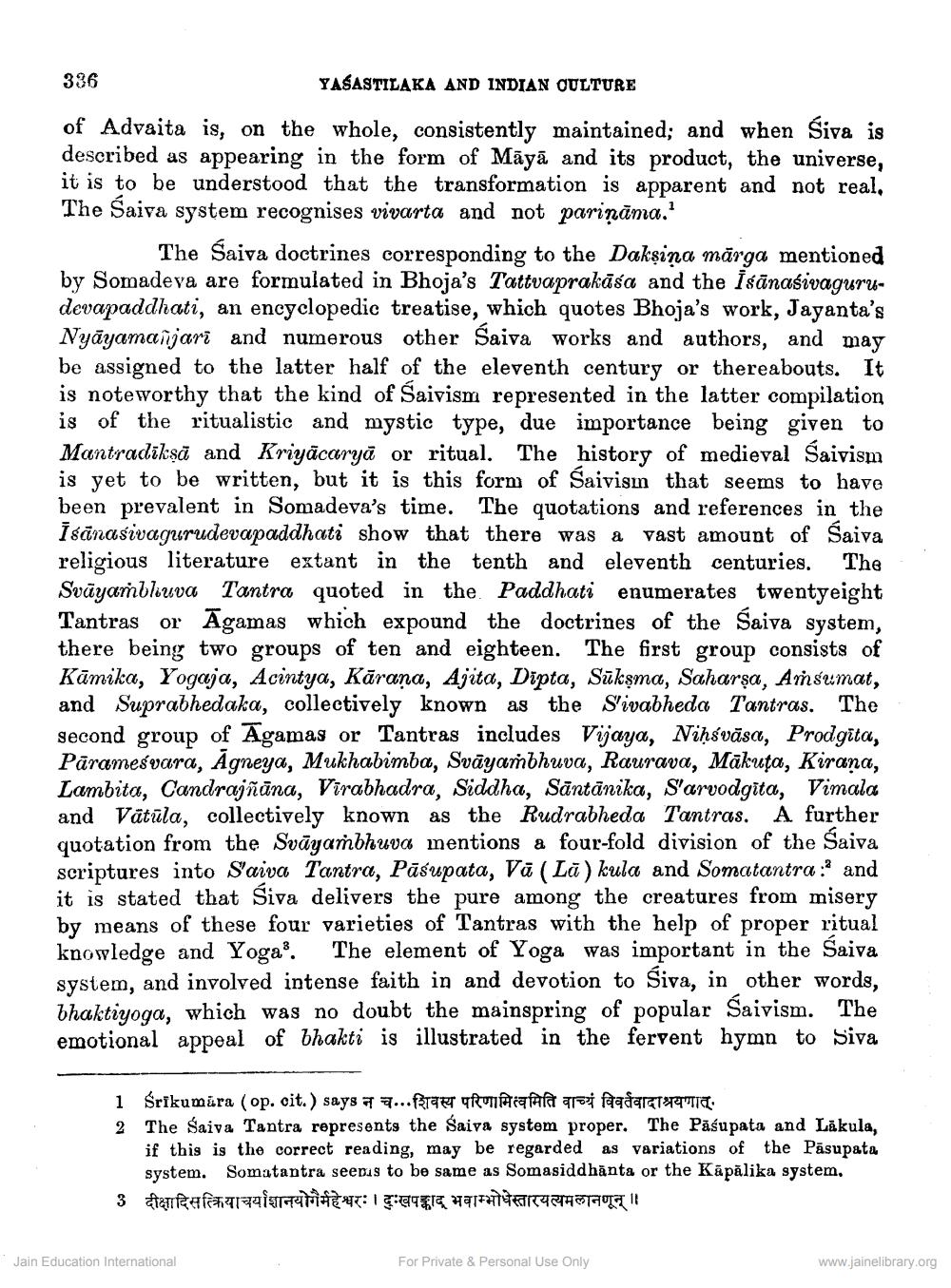________________
336
YASASTILAKA AND INDIAN CULTURE
of Advaita is, on the whole, consistently maintained; and when Siva is described as appearing in the form of Māyā and its product, the universe, it is to be understood that the transformation is apparent and not real, The Saiva system recognises vivarta and not parināma.'
The Saiva doctrines corresponding to the Daksina mārga mentioned by Somadeva are formulated in Bhoja's Tattvaprakāśa and the Isānaśivagurudevapaddhati, an encyclopedic treatise, which quotes Bhoja's work, Jayanta's Nyāyamasjari and numerous other Saiva works and authors, and may be assigned to the latter half of the eleventh century or thereabouts. It is noteworthy that the kind of Saivism represented in the latter compilation is of the ritualistic and mystic type, due importance being given to Mantradiksā and Kriyācaryā or ritual. The history of medieval Saivism is yet to be written, but it is this form of Saivisin that seems to have been prevalent in Somadeva's time. The quotations and references in the Īsānasivagurudevapaddhati show that there was a vast amount of Saiva religious literature extant in the tenth and eleventh centuries. The Svayambliuva Tantra quoted in the Paddhati enumerates twentyeight Tantras or Āgamas which expound the doctrines of the Saiva system, there being two groups of ten and eighteen. The first group consists of Kāmika, Yogaja, Acintya, Kārana, Ajita, Dipta, Sūkşma, Saharşa, Amsumat, and Suprabhedaka, collectively known as the Slivabheda Tantras. The second group of Āgamas or Tantras includes Vijaya, Niņsvāsa, Prodgita, Paramesvara, Agneya, Mukhabimba, Svāyambhuva, Raurava, Mākuţa, Kirana, Lambita, Candrajñāna, Virabhadra, Siddha, Sāntānika, Sarvodgita, Vimala and Vätüla, collectively known as the Rudrabheda Tantras. A further quotation from the Svāyambhuva mentions a four-fold division of the Saiva scriptures into Saiva Tantra, Pasupata, Vā (Lä) kula and Somatantra: and it is stated that Siva delivers the pure among the creatures from misery by means of these four varieties of Tantras with the help of proper ritual knowledge and Yoga. The element of Yoga was important in the Saiva system, and involved intense faith in and devotion to Siva, in other words, bhaktivoga, which was no doubt the mainspring of popular Saivism. The emotional appeal of bhakti is illustrated in the fervent hymn to Siva
1 Śrīkumira (op. cit.) says ... frakt forfcaffaari faadarte 2 The Saiva Tantra represents the Saiva system proper. The Pāśupata and Läkula,
if this is the correct reading, may be regarded as variations of the Pāsupata
system. Somatantra seerus to be same as Somasiddhānta or the Kāpălika system, 3 दीक्षा दिसत्क्रियाचर्याशानयोगैमहेश्वरः । दुःखपङ्काद् भवाम्भोधेस्तारयत्यमलानणून् ।।
Jain Education International
For Private & Personal Use Only
www.jainelibrary.org




